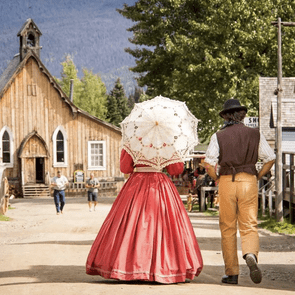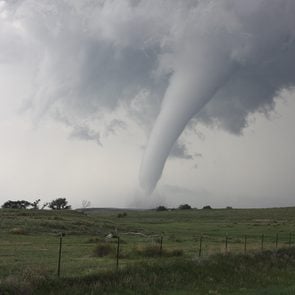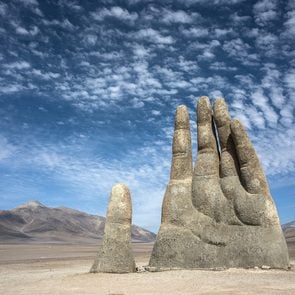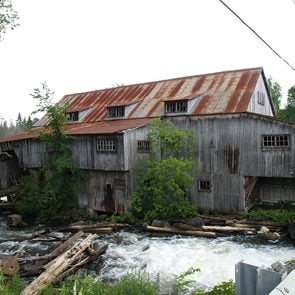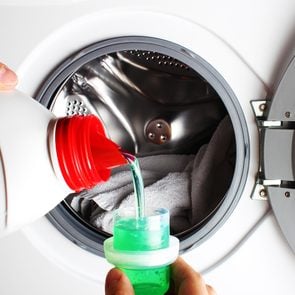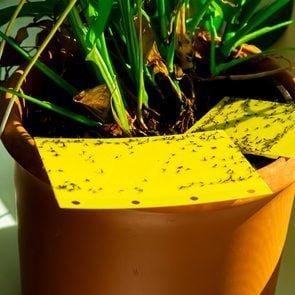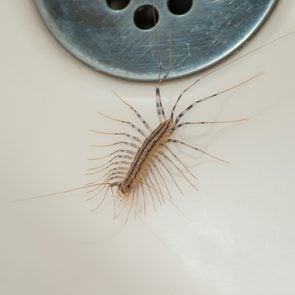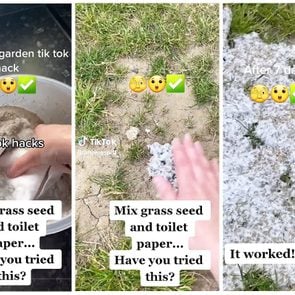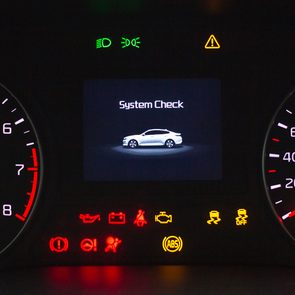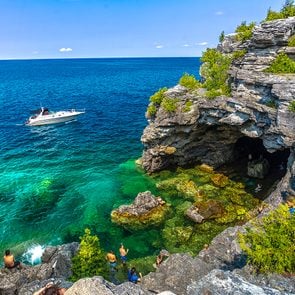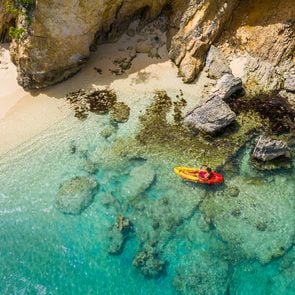Vancouverites love to complain about the soggy weather, but imagine living in a place that gets four times as much rain. That would be Hucuktlis Lake (formerly Henderson Lake), a crescent-shaped body of water surrounded by mountains near the west coast of Vancouver Island. With average annual precipitation of 6,903 mm—yes, that’s almost seven metres—this fish- and wildlife-rich rainforest zone is on par with the rainiest parts of Costa Rica.
Hucuktlis (pronounced “who-chook-tlis”) Lake currently holds the all-time North American record for annual precipitation, set in 1997 with a staggering 9,307 mm over 252 rainy days that year. The area’s unique geographic features are thought to contribute to its heavy rainfall, with a chain of inlets connecting the lake to nearby Barkley Sound acting as funnels to pull warm, moist air inward from the Pacific. Much of the west coast of Vancouver Island also experiences a phenomenon called “orographic lifting”—prevailing winds move from west to east from the Pacific, and as they’re forced upwards over mountainous terrain, the rising air cools, condenses and forms rain clouds. This is why coastal mountains get soaked, while the air grows drier as it moves inland.
View this post on Instagram
But perhaps there is also another reason for Hucuktlis Lake’s prodigious downpours. Situated on the traditional lands of the Uchucklesaht Tribe, the lake’s most notable feature is the T’iitsk’in Paawats Protected Area, also known as Thunderbird’s Nest, where tribe members still carry out spiritual practices. A 2,300-hectare preserve of old-growth forests, mountains, bathing pools and waterfalls, this sacred ground is said to be the home of the last living Thunderbird, a supernatural being important to many Indigenous cultures, especially of the Pacific Northwest. The most powerful of all spirits, Thunderbirds control rain and thunderstorms, and according to some legends they produce thunder by flapping their wings and lighting by flashing their eyes.
View this post on Instagram
The lake was previously named after Captain John Henderson, a master mariner who helped establish the Port Alberni sawmill in 1860. In 2018, the name was changed to Hucuktlis, which means “place way inside” in the Nuu-chah-nulth dialect of the Uchucklesaht, a language that’s been rendered endangered by assimilative policies such as the residential school system.
Although the city of Port Alberni is just 25 kilometres away, Hucuktlis Lake remains fairly remote. Hilthatis (or Ehthlateese), the closest village, counts only three permanent residents. Thunderbird’s Nest is accessible by boat or trail, and visitors are warned to watch out for bears and cougars. If you’re lucky, you might catch sight of a Roosevelt elk, one of the largest species of deer, which stands up to 10 feet tall. And you might want to bring your rain gear, too.
Now that you know the rainiest place in Canada, find out which city is known as the hailstorm capital of Canada.
With the dozens of passwords you need to keep track of, it’s tempting to find a simple string of letters or numbers to remember and stick with that. If it’s easy for you, though, it’s probably easy for hackers to figure out too.
Software company SplashData analyzed more than 5 million leaked passwords to find out which were the easiest for hackers to figure out. For several years in a row, “123456” and “password” topped the list of worst passwords. They’re likely among the first passwords an identity thief will try, so you’re leaving the door wide open for crooks to steal your information. (Here’s expert advice on how to prevent identity theft.)
Don’t think that sneaky letter-to-number trick will save you either. Nineteen on the list was “passw0rd,” using a numerical zero instead of the letter “o”. “Hackers know your tricks, and merely tweaking an easily guessable password does not make it secure,” says SpashData CEO Morgan Slain in a press release.
Using your hobbies and interests could be easy to figure out too. Also on the top 25 worst passwords were “football” (9), “monkey” (13), “starwars” (16), and “dragon” (18). Cutesy sayings also weren’t hard to crack. Some of the most common included “letmein” (7), “iloveyou” (10), “welcome” (12), and the creative “trustno1” (25).
Using an easy-to-guess password makes it easy to steal your data. Reusing those same weak passwords across multiple accounts means if a hacker gets into one account, you leave the door open for him or her to make it into other accounts more easily, too.
The best passwords are at least 12 characters long, and use a mix of characters such as capital and lowercase letters, according to SplashData. Using a fresh password for every account also helps, so use a password manager to keep you organized. If the password is so hard that even you can’t remember it, a hacker will have a hard time breaking in, too.
Brush up on the latest scams across Canada.
Here are the 25 worst passwords for online security
123456
password
12345678
qwerty
12345
123456789
letmein
1234567
football
iloveyou
admin
welcome
monkey
login
abc123
starwars
123123
dragon
passw0rd
master
hello
freedom
whatever
qazwsx
trustno1
[Source: Mental Floss]
Next, find out why you need to stop commenting on those viral Facebook memes.

As a young college student transitioning to the work force, I realized I had to have a car to get around. I had a part-time job at a discount shoe store in St. Catharines, Ontario, while completing my broadcasting course at the local community college. I had to hitchhike and cadge rides to and from school, located miles away in another town, with no bus service to it. I wanted a car but couldn’t afford it.
My dad came to the rescue, sort of. He had a dark purple 1963 Ford Galaxie 500, but was getting a newer car to better suit his job as interior decorator for Sears Canada. He gave me the old Ford, with over 200,000 miles (320,000 kilometres) on the odometer, and wished me luck.
I did not have my driver’s licence at that time, only my learner’s permit, but I became familiar with the Ford Galaxie by driving it up and down the driveway, saving my money for car insurance. Getting my licence at last in 1973, I was thrilled to be able to take to the open road. One day shortly after becoming street-legal, I went out to the Ford and started ’er up. It was only a six-cylinder, but out came a mighty roar as the engine turned over—I had blown out the muffler!
So, no driving for me until I could save up enough for a new muffler. Getting that car drivable was now urgent because I had been offered a part-time reporting job at the radio station where I did my work placement for college.
Finally getting that old beater on the road, I started my broadcasting career. I was young but the car was not. It didn’t like my driving style as I rushed from school to get to my radio reporting assignments and back again. I pushed that old high-mileage engine for all it was worth.
One spring Sunday I had to be at the radio station by 6 a.m. to prepare the morning newscasts. It was a windless day, absolutely calm at that time of the morning. The sun was barely up. My route took me downtown past the main firehall. I had to wait for a light to turn green, so I sat there in the Ford, engine idling. I was a bit amazed that a light fog was forming. Suddenly, there was a loud knock on my window—and a firefighter yelling at me that
my car was on fire!
I quickly put the car in “Park” and jumped out. Smoke was billowing out from under the car in great white clouds. The firefighters lifted my hood, extinguishers at the ready, and then they started laughing.
The car wasn’t on fire. It was burning so much oil that in the calm morning air, with no breeze to disperse the smoke, it looked like it was ablaze. There was clear air all round it, but it sat in its own little island of man-made fog. It was an embarrassing moment.
I was taken on full-time at the radio station shortly after, which enabled me to get a bank loan I needed to purchase a new-to-me used car, which turned out to be a V-8 Buick LeSabre.
Before purchasing it, I made sure to really run the engine and check that that the exhaust was functional and clean. That car cost me a whole $1,000. The dealership took my Galaxie in trade and gave me a whopping $25 for it. I’m sure even at that, they were doing me a favour.
How did your first car compare to this old Ford Galaxie? Share your story with Our Canada!

Last year, my wife Annette and I decided to visit our friends in Guazacapán, Guatemala. They operate a mission called “Power At Work,” which aids and supports the people in the area. We would assist them by delivering tables and bunk beds, made in the workshop on the base, to needy families, as well as help deliver food for their feeding program.
Our hosts asked us what we would like to do on a “day away” for sightseeing. After some discussion, we decided to climb the Pacaya volcano, which is over 2,552 metres above sea level.
Pacaya, once dormant, began erupting in 1961 and has had several lava flows since. The latest eruption occurred in 2021, when the volcano sent lava and ash over corn fields and cow pastures, while also burning a small village in its path. The Pacaya volcano is near Escuintla and around 50 kilometers from Antigua.

We headed up to register and pay for our assigned guide, whom we were very grateful to have with us. Our group of nine assembled for the adventure, outfitted with good walking shoes, extra water and lunch.

We started the arduous climb through loose stones and lava dust. We refused the horseback option, as we were determined to hike on our own strength. We took many rest stops along the way to catch our breath, drink some water and take pictures, before reaching a plateau. From there, we made our way across the most recent lava flow, on a path to our end destination.

We found a suitable place to sit, enjoy our lunch and have some much-needed rest after the two-hour climb. During our lunch break, the fog rolled in and obstructed the views we saw earlier. Our guide supplied us with sticks and marshmallows to roast in some of the hot spots in the craggy rocks.

With our upward adventure completed, we descended slowly and carefully but we slid and slipped down Pacaya’s uneven and steep trails. Exhausted but exhilarated, I could now check this volcano experience off my bucket list, an item I had added that morning.
If you’ve just added Mount Pacaya to your own bucket list, you’ll love our roundup of the world’s greatest hikes.
The amber glow of twilight reflects eerily off the mirror-like surface of B.C.’s Lake Okanagan. The unearthly silence is suddenly broken when a long sinuous wave erupts in the middle of the lake. It doesn’t speed towards shore as waves do. Instead, it holds a steady course on the ever-darkening waters…
The Ogopogo Legend
First Nations of the Okanagan Valley speak with reverence of N’ha-a-a-itk, protector of the lake. A spirit being able to manifest in physical form, ancient petroglyphs depicted it as a 25-metre-long serpent with a smooth green or black body, swimming freely around the lake, snacking on kokanee salmon.
Early settlers to the Okanagan Valley also describe encounters with a gargantuan sea serpent. In 1872, a local author wrote of seeing an enormous snake undulating across the lake. Similar sightings sparked widespread hysteria that a large aquatic creature was on the prowl. In the 1920s, local tourism officials began referring to N’ha-a-a-itk as Ogopogo, after a popular British dance tune—an attempt to give it a less harrowing-sounding moniker. In spite of the rebranding, sightings of a fearsome lake creature continued, and as recently as 2020, a local television station aired a video of something dark—allegedly Ogopogo—bobbing in the waves.
According to Bill Stecuik, an avid Ogopogo researcher who manages the website OgopogoQuest.com, a popular theory is that it’s a prehistoric whale, Basilosaurus cetoides, that calls the lake home.
For decades the legend of Ogopogo has attracted visitors to the Okanagan Valley. In the 1980s , the mania reached new heights when the region’s tourist association offered $1-million for proof of the creature’s existence. Out of an abundance of caution for Ogopogo’s wellbeing, this prompted the environmental group Greenpeace to list it as an endangered species not to be harmed or captured.

From terrifying lake monster to beloved tourist attraction, the shoreline is now graced by a large plaster statue, paying homage to a grinning Ogopogo—great for a selfie if you missed seeing the real McCoy. And the Ogopogo legend continues to evolve. The Okanagan Heritage Museum features a display explaining how N’ha-a-a-itk, the lake spirit, became Ogopogo the lake monster. In this tale, the ethereal lake serpent sacred to Okanagan Valley First Nations is revered. Ogopogo remains a cultural icon, but now as a being that inhabits both the spiritual and physical realms and can watch unfettered all that happens on Lake Okanagan.
Regional Variations on the Legend of Ogopogo
Cressie
Similar to the Ogopogo legend, Indigenous folklore describes a serpent living in Crescent Lake, Newfoundland and Labrador.
One of the most notable sightings of the creature—now known as “Cressie”—dates back to 1991, when a retired schoolteacher claimed to witness a 6-metre-long eel swimming close to shore. When the History Channel aired an episode on Cressie as part of its MonsterQuest series in 2008, it was suggested there wasn’t one creature, but in fact dozens living on the lake’s murky bottom.
Whatever their number, Cressie and “friends” are camera shy, making it impossible to say if there’s anything unusual skulking in Lake Crescent. This doesn’t bother the town of Robert’s Arm on the lake’s edge, though. Like the legend of Ogopogo, Cressie’s good for tourism—and a great yarn after some Newfoundland screech.
The Memphre
Something so terrifying lurks in Quebec’s Lake Memphremagog that local First Nations told early settlers they were too frightened to swim there.
Whatever’s in the water isn’t shy. A University of Sherbrooke research project discovered there’d been 215 sightings of the Memphre in the 20th century alone, including an incident in 1961 when two fishermen claimed a 12-metre long serpent swam under their boat. Talk about the one that got away!
In 2011, the Canadian Mint immortalized the Memphre issuing an oversized coloured quarter with its likeness as part of its mythical creature series.
Kempenfelt Kelly
In 1881, a surveyor working in the marshes surrounding Ontario’s Lake Simcoe told a local newspaper he saw a creature bigger than a human slithering out of the rushes into the lake.
Commonly referred to as Kempenfelt Kelly, after the bay extending out from the City of Barrie, the creature has latterly been described as having a long, thick neck and the head of a dog.
When sightings dried up in the 1970s, many believed Kelly had met its demise. But not to be counted out, in 1991, a grainy video showed something larger than the lake’s resident beavers rise vertically out of the water. The footage brought the Kelly legend back to life. A wily creature, a search by the Discovery Channel in 2005 proved inconclusive. The question remains: when will Kelly resurface?
Manipogo
Straight out of Jurassic Park, Manipogo’s reptilian body is said to rise out of the waters of western Manitoba’s Lake Winnipegosis with a blood curdling shriek.
The lake links up with Lake Manitoba, and a creature matching Manipogo’s description has been seen there, as well. Most alarming, though, is that on August 10th, 1960, 17 witnesses claimed to see three Manipogo swimming together. To put an end to the speculation once and for all, a professor from the University of Manitoba launched an exhaustive search in the early 1960s, but found no evidence to suggest one or more of the creatures ever inhabited Manitoba’s waterways.
But, like the legend of Ogopogo, sightings continue. In 2011, security teams patrolling flood zones in southern Manitoba reported seeing something large with protruding humps swimming in washed-out streets and fields.
Ol’Slavey
Great Slave Lake in the Northwest Territories is North America’s deepest lake, and the perfect place for an underwater lair. Rooted in Indigenous folklore, the Dene of the Northwest Territories have spoken for centuries about a dragon living in the lake and surrounding waterways. Naysayers claim it’s just a big fish, but in 2004, a Roman Catholic priest told local media he had seen a dragon-headed serpent rise out of the water.
Whether it’s the legend of Ogopogo, Ol’Slavey or The Memphre, these great Canadian sea serpent stories certainly spark the imagination. Who knows what might suddenly manifest on a moonlit lake, while you sit by a campfire on the shore’s edge, roasting marshmallows?
Next, check out the most haunted places in Canada.
Various liquid and powdered laundry detergents may fill supermarket aisles, but you need to search high and low for an option that’s fragrance-free, lacks harsh chemicals and allergens and remains affordable. Tucked on those shelves, you’ll likely also find the ingredients for homemade laundry detergent. And making your own detergent is a quick and easy DIY project that lets you skip the extras and cut your final cost to a few cents per load.
Buying the individual ingredients and putting them together yourself lets you choose exactly what goes into your laundry detergent. Homemade cleaners can be environmentally friendly too, both in their ingredients and in their packaging. Instead of buying single-use plastic containers of liquid detergent, you can make powdered detergent from ingredients packaged in paper and cardboard and store your final blend in a reusable airtight container.
Discover more cleaning hacks that take the hassle out of housekeeping.
Before you start
Choose a soap that’s free of chemicals, fragrance and dyes, such as castile bar soap. Washing soda (sodium carbonate), sometimes sold as soda ash or crystals, is just baking soda (sodium bicarbonate) that has been heated to remove its natural moisture. It absorbs odours and brightens fabrics.
A few optional ingredients boost basic laundry detergent. Borax, a naturally occurring salt, acts as a softener and helps remove stains. However, a high pH makes it potentially irritating to skin, so leave it out if you have sensitivities. Keep the blend scent-free or, if you like a fragrant detergent, look for an essential oil at a local drugstore or natural goods store.
The powders in a detergent mix can be quite fine. If you’re concerned about breathing in the particles, put on a mask or choose a well-ventilated or outdoor space for detergent prep. Directly handling large volumes of the dry ingredients can be more irritating to skin than dissolving them in a load of wash, so pull on gloves before you begin.
It can be difficult to remove the soapy taste from the tools you use when making detergent at home, so you may want dedicated ones for this project.
How to make your own homemade laundry detergent
@haleigh021 #laundrydetergent #cleantok #moneysavingtips #savemoney #cleaningtips #momtok #momtips #familyof5 ♬ Heart Like A Truck – Lainey Wilson
This recipe yields about six cups of detergent, enough for up to 96 loads of laundry.
Ingredients
- 1 bar of soap, five ounces
- 2 cups baking soda
- 2 cups washing soda
Optional:
- 2 teaspoons Borax
- 6 to 10 drops essential oil, such as lavender or lemon
Tools
- Cheese grater: Choose a grater that will give you fine shreds of soap. The finer the shreds, the more easily the soap will dissolve in water.
- Large mixing bowl: A large, wide bowl lets you stir the lowest layer of powder into the mix without creating a cloud of particles.
- Half-gallon Mason jar with lid: An airtight lid on a glass jar or other storage container will help prevent clumping.
Directions
Step 1: Grate the soap
Using the cheese grater, grate the soap into fine shreds. Measure two cups of soap shreds into a large mixing bowl, storing any extra soap in an airtight container to use in your next batch.
Step 2: Mix in the powders
Slowly pour the baking soda and washing soda into the mixing bowl. If desired, add borax and a few drops of essential oil. Using a large wooden spoon, stir until well combined, using a gentle motion to keep the particles from dispersing into the air.
Editor’s Tip: If you devote a food processor to detergent making, you can create a finer powder with the machine’s grating and blending attachments. After stopping the food processor, let the mixture sit for a couple of minutes, until the dusty powder settles, before opening the lid.
Step 3: Store the detergent
Slowly pour or scoop the detergent into a half-gallon jar and seal it with an airtight lid. Label container and store it in a dry place out of reach of children.
How to use homemade laundry detergent
On laundry day, measure one or two tablespoons, for a small or a large load, into the drum of your washing machine before adding the laundry and starting the machine. Adding the homemade detergent directly to the washer drum keeps soap flakes from clogging the machine’s dispenser. If you have hard water and notice soap scum, reduce the volume of soap in your next mix.
Homemade laundry detergent FAQs
Does homemade laundry detergent go bad?
Laundry detergent won’t spoil, but it can clump and harden. Mixing it frequently in small batches keeps the detergent loose and powdery.
The dryness of washing soda helps minimize the moisture in the blend, but it’s still important to keep the detergent in a tightly sealed container and store it in a non-humid place. A dry upper cupboard is a better location than under the laundry room sink or on a shelf over the dryer.
Can I use homemade laundry detergent on whites and delicates?
DIY detergent brightens whites and gently cleans delicate clothing, so you can use it on all of your laundry. Adding borax can help tackle tough stains, but as a potential irritant, it may be best left out of detergent for delicates.
Homemade detergent can also be used to pretreat stains, but leaving it on too long might weaken delicate fabrics and affect colours. It’s better to load and start the machine than let fabrics sit overnight against the detergent.
Next, find out the laundry mistakes everyone makes—and how to fix them.
Though we’re well into September, many homeowners are still dealing with pesky wasp invasions. And while there are numerous chemical solutions to eradicate wasps, some people seek gentler and less dangerous methods to deter the pests.
Enter the latest viral wasp solution: using a plain paper bag to force wasps to move out.
The phrase “wasp paper bag trick” has drawn more than 270 million views on TikTok, thanks to its surprising and humorous approach. But is it really effective? In this story, we’ll fact-check the trendy pest control trick.
What is the paper bag wasp deterrent trick?
On TikTok, Pivot Farm (@pivotfarm), a family account for homesteaders Brandelyn and Joe Tafoya, tries the hack. The video’s narrator—presumably Joe—explains:
“I saw somewhere on a video that said if you hang a bag next to your wasp nest it’ll make them move out because they’re super territorial.”
The camera then pans over to show a brown paper bag hanging about a foot or two away from a wasp nest, seemingly devoid of insects.
Here’s the idea behind the paper bag wasp deterrent trick: If you hang a paper bag that’s slightly inflated, the wasps will mistake it for a rival nest and vacate the real hive, avoiding the use of harmful chemicals or expensive treatments.
@pivotfarm Wish I had known this sooner! Chemical free hornet nest removal! #homehacks #househacks #farmhack #hometips #farmtips #homestead #beesnest ♬ original sound – Brandelyn Tafoya
Does the paper bag wasp deterrent trick work?
In the video, Joe Tafoya says he “never thought [the trick] would work.” And yet, he claims, it did: “In about two weeks, they all just left.”
Hundreds, if not thousands, of users echoed their enthusiasm for the method. That includes Jean H. Spin, who according to USA Today posted the trick on Facebook in 2020.
However, experts on wasp behavioUr warn the paper bag deterrent trick isn’t foolproof. Michael Skvarla, Ph.D., an assistant research professor of arthropod identification and director of the Insect Identification Laboratory at Pennsylvania State University, told USA Today the wasps usually aren’t fooled.
“[P]aper bags and other devices don’t stop wasps from nesting because they don’t perceive such objects as nests,” he says.
Why not? “[P]aper bags lack any smells or chemical cues that would indicate they’re nests and do not have worker wasps defending them,” Skvarla says. Ultimately, he adds, “[W]hile wasps are highly visual insects, the simple shape of an object isn’t enough to deter them.”
Are there any risks to using paper bags as wasp deterrents?
Unfortunately, it’s possible hanging a paper bag next to a wasp nest could actually encourage the pests to stay put. That’s because wasps use paper to build their nests, so they may find this a welcome help in crafting their new home.
Additionally, wasps often nest inside commercial products, according to Skvarla. So the paper bag trick may be “providing habitat to wasps rather than deterring them.”
How should I properly deter wasps?
In most instances, Skvarla suggests leaving the wasps be. They serve a purpose in your yard, acting as natural pest control for other insects, like caterpillars and flies. However, if a wasp nest poses an immediate safety risk—say, when it’s in a high-traffic area, or someone in your home is allergic to wasp stings—Skvarla says it needs to go.
To remove a hanging wasp nest, opt for a long-distance spray killer, or even a DIY mix with Dawn dish soap. Apply it in the evening, early in the season. For next year, you can also prepare to eliminate the wasp queen in springtime. Stay safe out there!
Next, check out 13 secrets exterminators want you to know.
We were halfway across the country when our van’s check engine light came on. We took it to a dealer, who charged us thousands of dollars for parts that didn’t fix the problem.
That’s when we bought our first car diagnostic scanner. Within an hour we figured out the actual problem, which ended up being a $150 part that took less than an hour to replace.
We’ve since heard similar complaints from many other people. A lot of it has to do with the increasingly complex electrical and emission systems and sensors in today’s vehicles. But if you have a little wrenching knowledge, you don’t necessarily have to be at the mercy of the repair shop.
Here’s what a car diagnostic scanner can do for you, and those annoying warning lights on your dashboard.
What is a car diagnostic scanner?
A car diagnostic scanner—aka an on-board diagnostics scanner or an OBD2 code reader—is a device that communicates with your vehicle’s computer system to retrieve information about its performance and potential problems.
“Since 1996, every car, light truck, SUV, minivan and hybrid sold in North America has been required to have an on-board diagnostic [OBD2] system,” says Keith Andreasen, an Automotive Service Excellence (ASE) certified master technician and tool product manager at Innova Electronics.
“It monitors a vehicle’s systems that trigger the check engine light and alert drivers about issues related to emissions, fuel economy and drivability.”
What can a car diagnostic scanner do?
It helps DIYers and professional automotive technicians figure out what’s wrong with a vehicle.
Some scanners just read codes, while others are more complex, monitoring real-time data. All OBD devices plug into a standardized port, usually under the steering wheel.
All OBD devices read diagnostic trouble codes (DTCs) generated by the vehicle’s onboard computer. “The scanner can display these codes in a human-readable format, helping users identify the problem area,” says Andreasen.
Other functions of car diagnostic scanners can include:
- Clearing trouble codes once a vehicle has been fixed, which will turn off the check engine light, the tire pressure sensor light and other warning signals.
- Monitoring real-time data for various sensors and systems, like engine RPM, vehicle speed, coolant temperature and oxygen sensor readings.
- Retrieving freeze-frame data, a snapshot of the vehicle’s system when the code was triggered.
- Viewing live data streams from multiple sensors to diagnose complex issues that involve interactions between systems.
- Letting you know if your vehicle will pass an emissions test.
- Retrieving information like VIN numbers and system calibrations.
- Performing active tests (bi-directional controls), during which you can send commands to the vehicle’s systems and components.
- Installing software updates.
What can’t a car diagnostic scanner do?
While the capabilities of OBD2 devices vary depending on their price and manufacturer, in general they cannot:
- Repair your car for you.
- Predict future failures, although some databases, apps and solutions can help with that when used with a scanner.
- Diagnose non-electrical issues like low tire tread, a failing water pump or poor fuel quality.
- Override vehicle safety systems and manufacturer settings.
- Replace proper maintenance, like oil changes and fluid checks.
- Provide detailed mechanical diagnosis. “While scanners can point out areas of concern, they might not provide detailed explanations for the root cause of a problem,” says Andreasen. “This often requires further investigation by a skilled mechanic.”
Who needs a car diagnostic scanner?
It’s a valuable tool for anyone who likes to work on their car, because it lets you problem-solve repairs without paying an auto mechanic to do it.
“A consumer with little automotive repair experience can use a diagnostic scanner to check a vehicle for road trip readiness, see if their car is ready to pass an emissions test, or better understand why the check engine light is on,” says Andreasen.
If you’re not ready to buy one yet but your check engine light is on, most auto parts stores carry basic code readers and will read your code for free on the spot.
Next, check out 20 car tools no home mechanic should be without.

My husband, Murray, and I live in Listowel, Ontario, and have travelled far and wide—only to meet up time and again with people who have connections to our hometown.
Listowel is a small but growing farming community in the middle of southwestern Ontario. It’s home to many agriculturally based industries, with Erie Meats, Spinrite Yarns and Carson Farms, and a lot of feed, seed, tractor and combine stores. So, not famous for a whole lot—maybe Letterkenny, on which our town is said to be based. Instead, it’s known for the amazing people who call it home.
We are a community known for hard work, generosity, support in tough times and a general rallying of the troops to “get ’er done!” I believe that it’s because of these strong, deep ties that, as we travel, we keep running into folks that know someone in Listowel!

Representing Listowel, Ontario
Take the time we were in London, England, to visit one of our sons, Josh, who was teaching abroad. We took a walking pub tour one evening when fellow Canadian travellers noticed Murray’s Maple Leaf hat. We struck up a conversation and, sure enough, the couple have a cousin who lives in Listowel—and yes, we know her!
On to Reykjavik, Iceland: We’d disembarked from our cruise ship and decided to stroll around the city for the day. After an hour or so, we were stopped by a couple looking for directions. They were from Calgary. So we got to chatting and, sure enough, one of them has a cousin who lives in Listowel. And, yes—we know her, too!
Walking down a beach in Punta Cana several years ago, we heard a man’s voice saying, “I think that’s Murray Beirnes who we just passed.” Sure enough, we turned around to see one of Murray’s co-workers from the Home Hardware distribution centre back home. Neither knew the other was coming to Punta Cana for a vacation. As it turned out, we were even staying at the same resort—and in the same building!
On to Montevideo, Uruguay—now that is a long way from home! Murray was proudly wearing his Home Hardware hat and “Guelph Storm of the OHL” T-shirt. A young man on the street commented on his shirt and then noticed the hat. It turns out that he was a friend of Walter Hachborn’s grandson—of course, Hachborn is one of the founders of Home Hardware!

From Sea to Shining Sea
But this small-world story is really topped by what happened on our Canadian travels—namely, during a visit to Winnipeg in 2018.
We were heading to Thompson, Manitoba, to visit our eldest son, Jeremy, and his family, and decided to explore Winnipeg for a few days before heading north. One evening, we were meandering through a neighbourhood along the river, looking at the lovely homes and stately trees. I stopped to take a photo of a house that captured my attention. Just then, a woman strolled by, curious, so I told her I was a pushover for a beautiful house. She asked us where we were from and we told her we lived in Ontario. When she asked us to be more specific, we said, “Listowel.” It turned out that she’d been born and raised just outside of our community, but moved to Winnipeg for university and ended up staying there.
Yet another connection: She told us that her maiden name was Rutherford. That rang a bell, as Murray’s parents had friends in Listowel named Harry and Goldie Rutherford—this woman’s parents! In fact, the Rutherfords’ home in Listowel was the very house that Jeremy had bought (before his move west) after the couple had passed away!
Another cross-Canada connection: Our youngest child, Jordan, and his wife, Sylvia, were once at a restaurant in Truro, Nova Scotia, when a trio of gents walked in. Jordan thought he recognized one of them and, as they chatted, realized the man was a former OPP officer from Listowel whose son was on a local minor-league hockey team that Josh had coached!
Clearly, Listowel, Ontario lives strong in the hearts of our kids, too.
Next, check out 25 inspirational pictures that’ll spark your wanderlust.
When it comes to easy meals, nothing beats a hearty salad, whether it’s a garden salad, a Caesar salad or a protein-packed salad for dinner. Whatever your preference, though, it’s best to start with fresh ingredients.
So what happens when you reach into the refrigerator and find that the key ingredient for any of those salads—lettuce—is covered in red stuff? Although it may look nasty, it’s not necessary to toss out the whole head. Just romaine calm, because it’s an easy problem to fix.
What is your lettuce turning red?
There’s a fairly simple explanation, really. The red stuff that appears on your lettuce, often near the root, is what most professional chefs refer to as “rust.” It’s a pretty apt name once you think about it, given its brownish-red appearance. Your case of “rusty lettuce” is due to an excess of moisture during the storage process. The good news is, it looks worse than it actually is.
Is rusty lettuce safe to eat?
Yes, lettuce turning red is still good, so there’s no need to waste it. It may look unappetizing, but the situation is easily salvageable. All you need to do is slice off the rusty red spots with a chef’s knife. Remember to hold the lettuce steady and cut away from your body with a sharp knife. You’ll have fresh-looking lettuce in no time at all!
Next, find out the best apps to save money on groceries.
